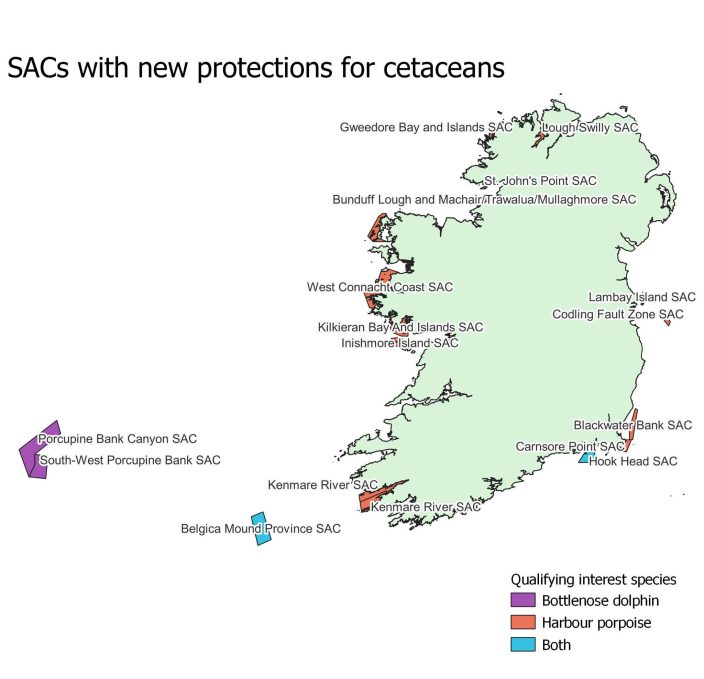NPWS adds new protection for cetacean species.
The Irish Whale and Dolphin Group (IWDG) and Fair Seas received notice this week from the Department of Housing, Local Government and Heritage that new cetacean measures have been added to existing Special Areas of Conservation (SACs), with harbor porpoise and bottlenose dolphins added as Qualifying Interests to 16 marine and coastal SACs.

Simon Berrow/IWDG
Current Special Areas of Conservation
Ireland designates SACs in its inshore and offshore waters under the EU habitats directive. This directive aims to protect marine habitats and species listed in Annex I and Annex II, which includes harbour porpoise and bottlenose dolphins as qualifying Interests (species requiring protection within the SAC). Currently there are just five SACs where either harbour porpoise or bottlenose dolphins are listed:
- Harbour porpoise: Roaring water Bay and Islands, Blasket Islands and Rockabill to Dalkey Islands
- Bottlenose dolphins: the Lower Shannon and West Connacht Coast
However, back in 2009, at the EU Commission’s Marine Atlantic Biogeographic Seminar, certain species including bottlenose dolphins and harbour porpoise were determined and “insufficiently represented” withing the current SAC network in Irish waters. Among the actions agreed by the Irish government at the time was the inclusion of harbour porpoise and bottlenose dolphins as Qualifying Interests to existing SACs.
The new measures
The new measures outlined in the notice sent this week summarises which SACs the Minister for Housing, Local Government and Heritage has chosen, with bottlenose dolphin, harbour porpoise, or in two cases both, now included as Annex II species in 16 marine and coastal SACs.
 Under the Habitats Directive, this designation requires the determination of appropriate conservation objectives and measures aimed at maintaining the favourable conservation condition of these protected species within the SACs. As part of the protection measures, specific activities known as Activities Requiring Consent (ARCs) have also been added to most of these SACs. ARCS “cannot be carried out, caused or permitted to be carried out or continued to be carried out in the SACs, unless it is with the consent of the Minister”. The ARCs that have been added include:
Under the Habitats Directive, this designation requires the determination of appropriate conservation objectives and measures aimed at maintaining the favourable conservation condition of these protected species within the SACs. As part of the protection measures, specific activities known as Activities Requiring Consent (ARCs) have also been added to most of these SACs. ARCS “cannot be carried out, caused or permitted to be carried out or continued to be carried out in the SACs, unless it is with the consent of the Minister”. The ARCs that have been added include:
- ARC 06: Introduction, or re-introduction, of plants or animals not found in the area.
- ARC 31 Developing or consenting to the development or operation of commercial recreational/visitor facilities or organised recreational activities.
- ARC 35: Undertaking active acoustic surveys in the marine environment.

Simon Berrow/IWDG
What does this mean for these species and what are the next steps?
This news is welcomed by IWDG and Fair Seas. The addition of new cetacean protection measures to existing SACs in Ireland is a significant step towards enhancing the conservation of harbour porpoise and bottlenose dolphins in Irish waters. Protected Areas when managed correctly can protect and conserve vulnerable species, increase biodiversity, and enhance productivity. However, while SACs can serve as a tool to protect the marine environment, the benefits of the SACs already designated in Irish waters has been minimal and, in some cases, non-existent due to the lack of any effective management measures.
Moving forward, the National Parks and Wildlife Service (NPWS) faces the challenge of implementing and enforcing these new measures, particularly in offshore SACs where management complexities may be higher, and we will be interested to hear how these species will be protected in these offshore areas. IWDG and Fair Seas will be responding to the notice for clarification on certain aspects of these new measures, including the addition of harbour porpoise within the offshore SACs, and the relevance of ARC 06 and ARC 31 at the offshore sites.
Continued collaboration between stakeholders, robust enforcement of regulations, and adaptive management approaches will be crucial in maximizing the conservation outcomes of these protected areas. While the new measures are an encouraging step in the right direction, without effective management plans these SACs will simply become ‘paper parks’, existing only on paper, with quantity over quality prevailing.
By Becky Dudley,
IWDG Science Officer

